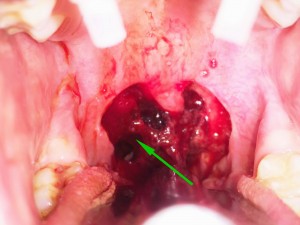Hemorrhage Post-adenotonsillectomy
Tonsillectomy (with or without adenoidectomy) is one of the most frequently performed pediatrics surgeries, both in general and pediatric hospital center. Although common, this procedure is not without risk. The post tonsillectomy bleeding is potentially the most frequently occurring lethal complication in 1-7% of cases. Even if bleeding is slight initially, the risk of progression to severe bleeding can reach 40%, all of which can rapidly progress to shock, airway compromise, and even death.
The post-tonsillectomy hemorrhage occurs within 24 hours following surgery or it occurs more than 24 hours after surgery, usually 5th to 10th postoperative day. This type of delayed bleeding occurs during the resorption of the clot at the tonsillar fossa.

Considering the risk of morbidity / mortality related to post-tonsillectomy bleeding, a conservative and aggressive management proves paramount even in cases where the bleeding seems weak or resolved. The child may have lost a significant portion of its circulating blood volume by swallowing it. In these cases, clinical bleeding signs are late and dramatic.
Patient support reached a post-tonsillectomy bleeding depends on the patient’s stability and intensity of blood loss.
However, because of the potential for progression to severe bleeding, even if doubt, you have to head to the emergency room of the nearest hospital for complete support.
Reference: Emergency department of CHU Sainte-Justine
__________________________
Emergency in ENT
Peritonsillar abscess
Ludwig’s Angina
Foreign body in the ear
Foreign body in the respiratory tract (nose, trachea, bronchi)
Foreign body in the esophagus
Epiglottitis
Epistaxis
Perilymphatic fistula
Nose fracture
Hemorrhage post-adenotonsillectomy
Acute mastoiditis
Facial paralysis
Sudden hearing loss
